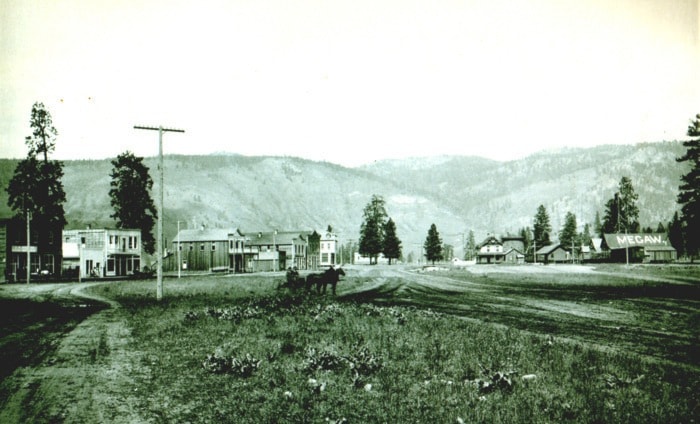Thirty-seventh in a somewhat alphabetical series on West Kootenay/Boundary place names
From 1899 to 1903, the west part of Grand Forks was a separate, rival city known as Columbia (That’s right: Columbia, British Columbia.)
Originally called Upper Grand Forks, a post office opened under that name on January 1, 1897, but when a Toronto syndicate bought the townsite, representative A.W. Ross lobbied for a name change. A postal inspector’s report claimed that mail bound for Upper Grand Forks was going to Grand Forks, North Dakota instead.
The first hint of the new name came in the Cascade Record of December 31, 1898 which suggested the town would be called Yale or Columbia. (Coincidence or not, the Yale-Columbia Lumber Co. was incorporated around the same time.)
The change officially took effect April 1, 1899 for postal purposes, but by then townsite promoters had been using the new name for months. Why Columbia? It seemed arbitrary. Postmaster Peter Wright told James White of the Canadian Geographic Survey: “The name of Columbia was selected on account of: 1) It being euphonious. 2) It being one of the names of the province. 3) The Columbia River being not far distant.”

Despite a modest population, Columbia became an incorporated city on May 4, 1899 and a feud began in earnest: a Grand Forks restaurateur was jailed for making malicious statements about Columbia; the Columbia stage coach refused to let passengers off in Grand Forks; and Grand Forks founding mayor John Manly was accused of helping burn down a Columbia hotel. (The charges were dropped when a key witness failed to show.)
Much to A.W. Ross’ dismay, the Canadian Pacific Railway depot at Columbia was called Grand Forks. He asked that it be changed — if not to Columbia, then Van Horn, Strathcona, Kettle Valley, or Kettle River — but was unsuccessful.
The rivalry finally ended in 1901 when residents of both towns voted to amalgamate, although it didn’t become official until January 1, 1903. Various names for the new city were suggested, including Amalga, Empire, and Miner.
The latter, in honour of Granby mining company president S.H. Miner, secured the most votes, but the Grand Forks board of trade later convinced the powers that be to stick with Grand Forks.
The name Columbia survived a while longer: the post office continued under that name until it closed on September 30, 1914, by which time the area was also known as Little Eholt. (We’ll deal with Eholt later in this series.)
The post office reopened as West Grand Forks on May 1, 1917, but newspaper references to Columbia persisted at least into the late 1930s.
One building from Columbia’s heyday, its train depot, still stands and is today the Grand Forks Station Pub and Columbia Grill.
Previous installments in this series
Applegrove, Appleby, and Appledale revisited
Bakers, Birds, and Bosun Landing
Bannock City, Basin City, and Bear Lake City
Boswell, Bosworth, Boulder Mill, and Broadwater
Brooklyn, Brouse, and Burnt Flat
Camborne, Cariboo City, and Carrolls Landing
Carmi, Cedar Point, Circle City, and Clark’s Camp
Carson, Carstens, and Cascade City
